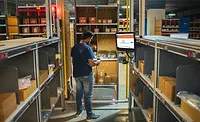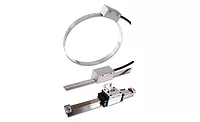Channel Strategies
Pandemic conditions boost eCommerce, beverage sales
Beverage category, alcohol sales thrive in 2020

Not a new trend, eCommerce’s growth has been evident for nearly a decade as the growth of technology has made shopping for anything, anytime from anywhere a part of daily life for many consumers. This year, however, the pandemic has influenced lifestyles and shopping habits, as many shoppers have enlisted eCommerce for their needs, including consumer packaged goods (CPG) consumables.
According to June 2019 survey data by Statista projecting for years 2015-2023, online retail sales accounted for 14.1 percent of all retail sales worldwide. With eCommerce continuing to grow at an increased rate between 4.1 percent and 6.2 percent throughout the past four years, Statista forecasts its global market share will increase to reach 22 percent in 2023.
COVID-19’s impact on eCommerce
As consumers engaged in pandemic-related shopping, eCommerce retailers experienced an increase in activity, with consumers trending toward buying online, says Tim Ahlenius, vice president for strategic initiatives at digital marketing agency Americaneagle.com, Des Plaines, Ill..
“We can gain more audience data [this way] because so much is being tracked online. We can now see who is shopping, when they are shopping, what is in their shopping cart, and purchasing trends,” he says. “We utilize this data in digital marketing to retarget this audience to better serve up strategic behavior buying products.”
Because most eCommerce purchases are happening on mobile, advertisers are ripe with opportunities to reach shoppers as consumers tend to browse longer when purchasing online, Ahlenius says. He adds that faster upsell capabilities and identification of brand loyalty is another advantage of eCommerce, creating valuable insights to immediate data on shopper tendencies.
However, this emerging market is not without its challenges.
“One disadvantage that eCommerce faces compared to other channels right now, is that the market is very saturated,” he says. “Some shoppers trust the first result they see on Google, making it challenging for businesses that do not have an SEO keyword strategy in place. Having better SEO and discoverability is so important.”
He adds cybersecurity is another challenge facing the eCommerce industry.
“It is crucial for businesses to stay on top of their security protocols because things are moving faster than ever in the eCommerce space,” he says. “Also, keeping up with order fulfillment in this climate will be crucial because of the lack of materials, supplies and logistics causing delays and challenges across industries.”
To combat these challenges, Ahlenius suggests that retailers clearly communicate what is in stock, maintain transparency in messaging, and ensure the brand’s visibility remains in-focus, which he says is accomplished through SEO, digital marketing, targeting, local partnerships and supporting local businesses.
Beverage seeing a boost
According to Ahlenius, COVID-19’s impact on eCommerce purchasing has extended to beverage purchasing because of on-premise closures.
“Costco, for example, has seen an increase in beverage sales,” he says. “In contrast, Starbucks has seen a decrease in beverage sales because people are working from home and not going out to buy their coffee.”
Looking at alcohol, Alex Smith, global sector lead at London-based Third Bridge, notes alcohol manufacturers have seen consumers’ drink purchasing shifting dramatically from liquor stores to delivery via online platforms.
"[These manufacturers] say [online purchasing] will reset the power balance between producers, distributors and vendors, eroding the influence of the established companies which have traditionally benefited through strong distributor relationships,” Smith says. “Instead, they expect data-rich online vendors, such as Drizly.com, will emerge with far greater sway and capacity to flex both price and brand exposure.”
In Beverage Industry’s June feature titled “eCommerce drives triple-digit growth in alcohol sales," the publication reported that alcohol eCommerce retail sales had jumped exponentially, up 234 percent for the weeks ending March 7-April 18, according to Nielsen data.
Drizly’s 2020 Consumer Report states that increased home consumption of alcohol is poised to endure. Drizly stated that even as states reopen for on-premise consumption, consumers who became accustomed to imbibing more frequently at home are likely to keep at it.
“70 percent of our respondents said they are planning to continue to drink less away from home, and 30 percent are poised to do so more at home for the remainder of the year, at least,” the report states.
In addition, online alcohol ordering and delivery have become mainstream, with 71 percent of current Drizly users and 50 percent of non-Drizly users anticipating at least 50 percent of their alcohol shopping taking place online versus in-store in the next year.
According to Third Bridge’s Smith, markets such as premium wines and spirits will be more eCommerce-inclined relative to categories such as beer and hard ciders. Ready-to-drink cocktails increasing popularity also is market to watch.
"The experts we're speaking to expect sales measured in dollars to continue to grow faster than sales by volume and the trend for premiumization to be sustained,” Smith says.
What comes next?
In its July “US Ecommerce by Category 2020” report eMarketer predicts that eCommerce market share in the United States will reach 14.5 percent of total retail sales in 2020, with food and beverage sales poised for a 58.5 percent total surge by end of year.
Americaneagle.com’s Ahlenius notes that by 2022, online grocery shopping as a whole is expected to be a $100 billion business, on the heels of platforms such as auto-reordering, subscription-based ordering features and growth of products like Amazon smart shelf. Ahlenius also sees cross-channel selling among multiple marketplaces such as an Amazon store and direct-to-consumer stores from big consumer brands.
“Retailers can best seize these opportunities by beginning to expand their eCommerce stores and digital marketing strategies to overcome challenges and thrive in this new and growing eCommerce space,” he says. “[Brands should] evaluate whether or not a subscription-based ordering system makes sense for their products and explore partnerships, both locally and within their industry sector.”
Coming down the pipeline in the years ahead, Ahlenius predicts direct-to-consumer brands putting more block chains in place, an emergence of more premium private-label brands, pop-up shops, shoppable TV ads, secondhand commerce (“recommerce”), and advanced personalization.
“Overall, we are going to see eCommerce continue on its rapid growth journey. We expect to see much more direct to consumer shops/private labels that will come to fruition from big brands and businesses alike,” he says. “We saw a large uptick in digital marketing with our eCommerce customers, and this will continue to advance forward as the space becomes so large.”
He also notes that machine learning and artificial intelligence sourcing also will increase, sustainability components of the fulfillment process will grow, and data shopping insights will continue to drive it all.
Looking for a reprint of this article?
From high-res PDFs to custom plaques, order your copy today!






